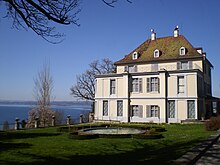Hortense de Beauharnais

Hortense Eugénie Cécile de Beauharnais (born April 10, 1783 in Paris , † October 5, 1837 in Arenenberg Castle in the canton of Thurgau ) was Queen of Holland and mother of Emperor Napoleon III. After the restoration of the Bourbon kingdom , she received the title of Duchess of Saint Leu .
origin
Hortense was the daughter of Alexandre, Viscount de Beauharnais and Joséphine Tascher de la Pagerie . After her father's execution during the reign of terror (1794) and her mother's remarriage (1796) to Napoleon Bonaparte , she became his step-daughter and adoptive daughter.
Marriage and offspring

In 1802 she got married to Napoleon's younger brother Louis Bonaparte , who was made King of Holland in 1806. The marriage took place mainly at the insistence of her mother Joséphine, because she had no children with Napoleon and hoped that a son of her daughter could become his heir. Hortense gave birth to three sons.
- Napoléon Charles Bonaparte (October 10, 1802 - May 4, 1807). He died at the age of four and a half and his body was ceremonially laid out in Notre Dame , Paris . He is buried in Saint-Leu-la-Forêt.
- Napoléon Louis Bonaparte (* October 11, 1804; † March 17, 1831), was Grand Duke of Kleve and Berg , briefly as Louis II. And Lodewijk II. King of Holland.
- Charles Louis Napoléon Bonaparte (born April 20, 1808 in Paris; † January 9, 1873), was Napoléon III from 1852 to 1870. Emperor of the French.
The chronically jealous Louis, however, did not recognize his fatherhood with their first son, but took Napoleon to be the father. He also had doubts about his third son, who later became Emperor Napoleon III. Hortense's marriage was not a happy one, and she and her husband separated in 1810.
Next life

Hortense had a fourth son, Charles Auguste Louis Joseph (1811-1865) , with her lover General Charles Joseph, Count of Flahaut . This was in 1862 by his half-brother Napoleon III. raised to Duke of Morny after he had helped him ten years earlier, in 1851/1852, with his coup d'état and his proclamation as emperor and had initially served as minister of the interior.
Despite the dissolution of her mother's marriage to Napoleon (1809) and despite her own separation from his brother, she supported Napoleon in his brief return to power in 1815. This led to her exile after his final defeat.
After traveling through Germany and Italy, Hortense bought the Seeheim estate near Konstanz in 1816 and the Arenenberg Castle in Salenstein am Untersee in the Swiss canton of Thurgau in 1817 . She lived there until her death in 1837. In the castle there is a Napoleon Museum, the Hortense's son Louis Napoléon, the later Emperor Napoléon III. , and whose family is dedicated. In 1858 the remains of Hortense were ordered by her son Emperor Napoléon III. transferred to the church of Saint-Pierre-Saint-Paul in Rueil-Malmaison near Paris. There a monumental marble grave memorial was erected opposite her mother's grave monument.
It is a legend that Hortense de Beauharnais was the namesake of the hydrangea plant genus , which came from her mother's homeland and was passionately loved by her. According to Antoine-Laurent de Jussieu, the botanist Philibert Commerçon gave this name as early as 1771, many years before she was born.
Hortense has long been credited with composing the melody of the song Partant pour la Syrie , which was written during the Second Empire under the reign of her son Napoléon III. fulfilled the function of a French national anthem. Presumably she was not the author, but a flautist at her court, Louis Drouet .
See also
literature

- Christina Egli, Dominik Gügel: Hortense de Beauharnais. Face à son destin. Labhards, Konstanz 2012, ISBN 978-3-939142-80-5 .
- Pierre Grellet: Queen Hortense on Arenenberg . New ed. and provided with a foreword and a biographical appendix by Dominik Gügel. Hubert, Frauenfeld et al. 2001, ISBN 3-7193-1262-3
- Dominik Gügel, Christina Egli: Hortense de Beauharnais. Fateful years of a queen . Labhard-Medien, Konstanz 2013 (special issue of Labhards Bodensee-Magazin ), ISBN 978-3-939142-80-5
- Alphons Nobel: Queen Hortense. Napoleon's heiress. Societäts-Verlag, Frankfurt 1938
- Jakob Hugentobler: Queen Hortense as the muse of song. In: Thurgauer Jahrbuch , Vol. 12, 1936, pp. 25–31 ( e-periodica.ch )
- Jakob Hugentobler: The letters of Queen Hortense to the Effinger von Wildegg , in: Writings of the Association for the History of Lake Constance and its Surroundings , 66th year 1939, pp. 35-69 ( digitized version )
- Hans Peter Mathis: The poetry album of Queen Hortense. In: Thurgauer Jahrbuch , Vol. 72, 1997, pp. 119–127. ( e-periodica.ch )
- Johannes Meyer: Queen Hortense and Prince Ludwig Napoleon , in: Writings of the Association for the History of Lake Constance and its Surroundings , 35th year 1906, pp. 123–307 ( digitized version )
- Friedrich Schaltegger : At the court of an ex-queen. From the diary of a lady of honor of Queen Hortense , in: Writings of the Association for the History of Lake Constance and its Surroundings , Volume 45, 1916, pp. 93–178 ( digitized ); 46th year 1917, pp. 105-165 ( digitized version ); 47th year 1918, pp. 119-182 ( digitized version ); 48th year 1919, pp. 1–44 ( digitized version )
Web links
- Literature by and about Hortense de Beauharnais in the catalog of the German National Library
- Napoleon Museum Arenenberg Castle
- Plant hydrangea and its naming
| predecessor | Office | Successor |
|---|---|---|
| --- |
King (in) of Holland 1806–1810 |
Charlotte Napoléone Bonaparte |
| personal data | |
|---|---|
| SURNAME | Beauharnais, Hortense de |
| BRIEF DESCRIPTION | Queen of Holland and mother of Emperor Napoléon III. |
| DATE OF BIRTH | April 10, 1783 |
| PLACE OF BIRTH | Paris |
| DATE OF DEATH | October 5, 1837 |
| Place of death | Thurgau |
